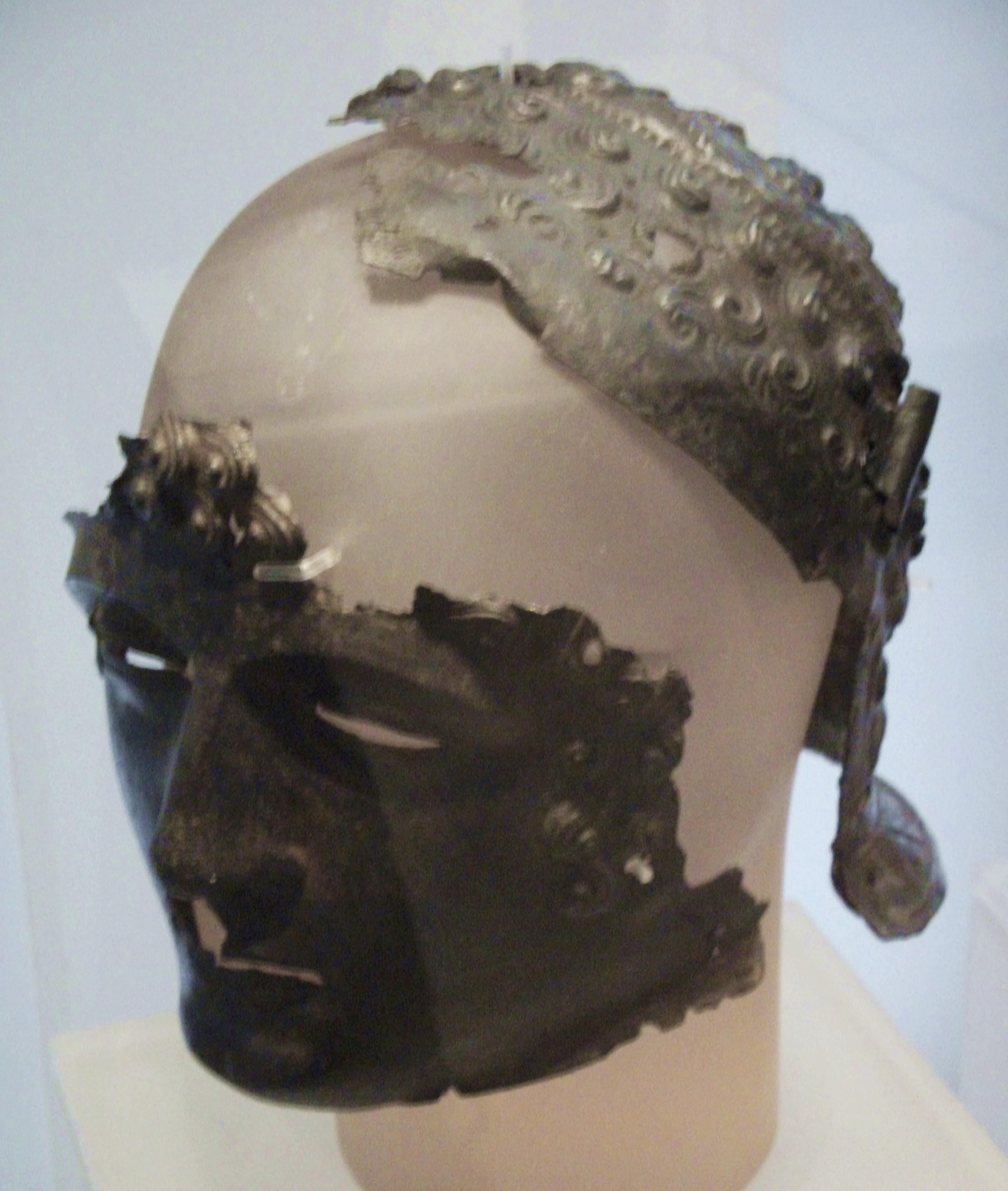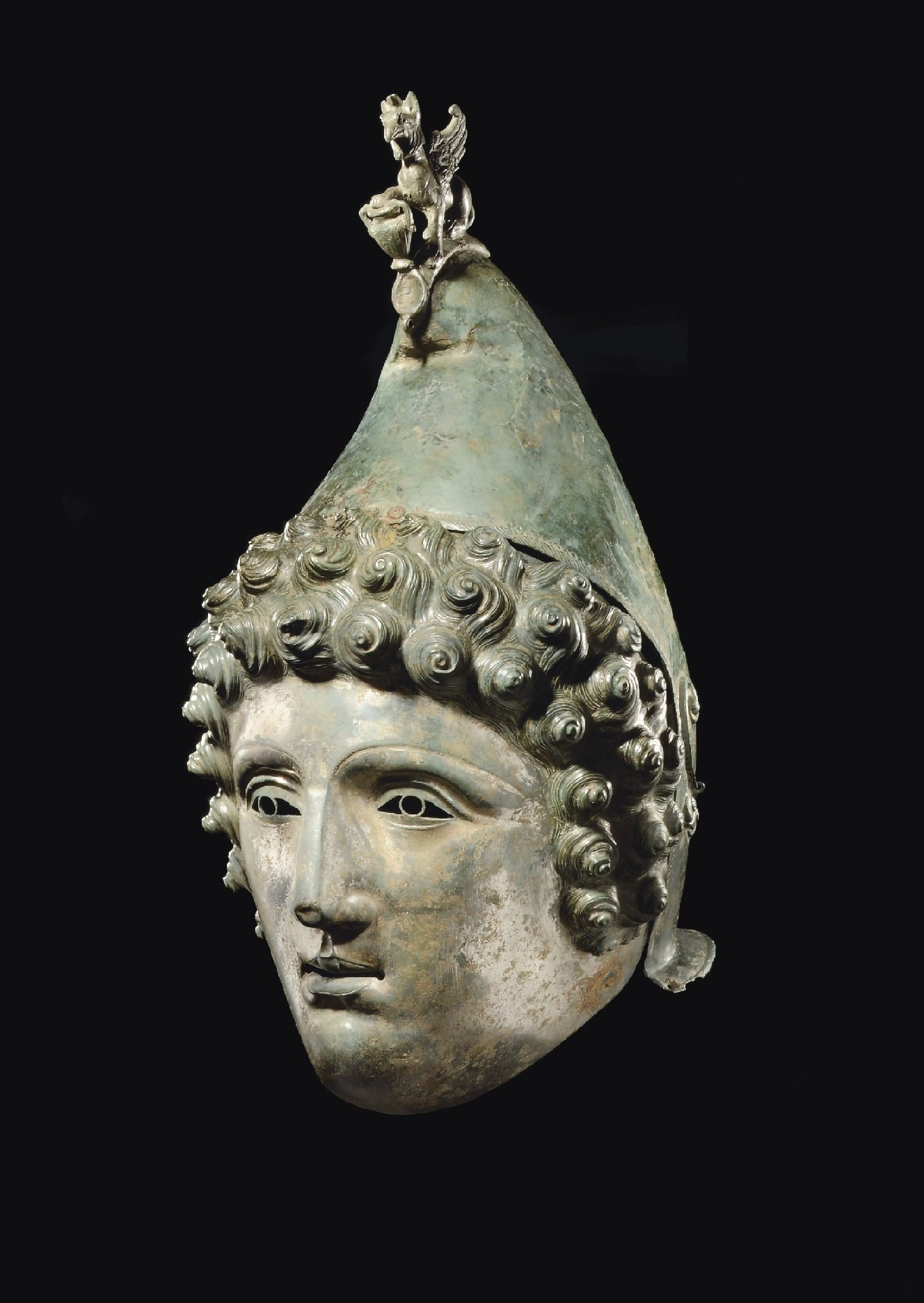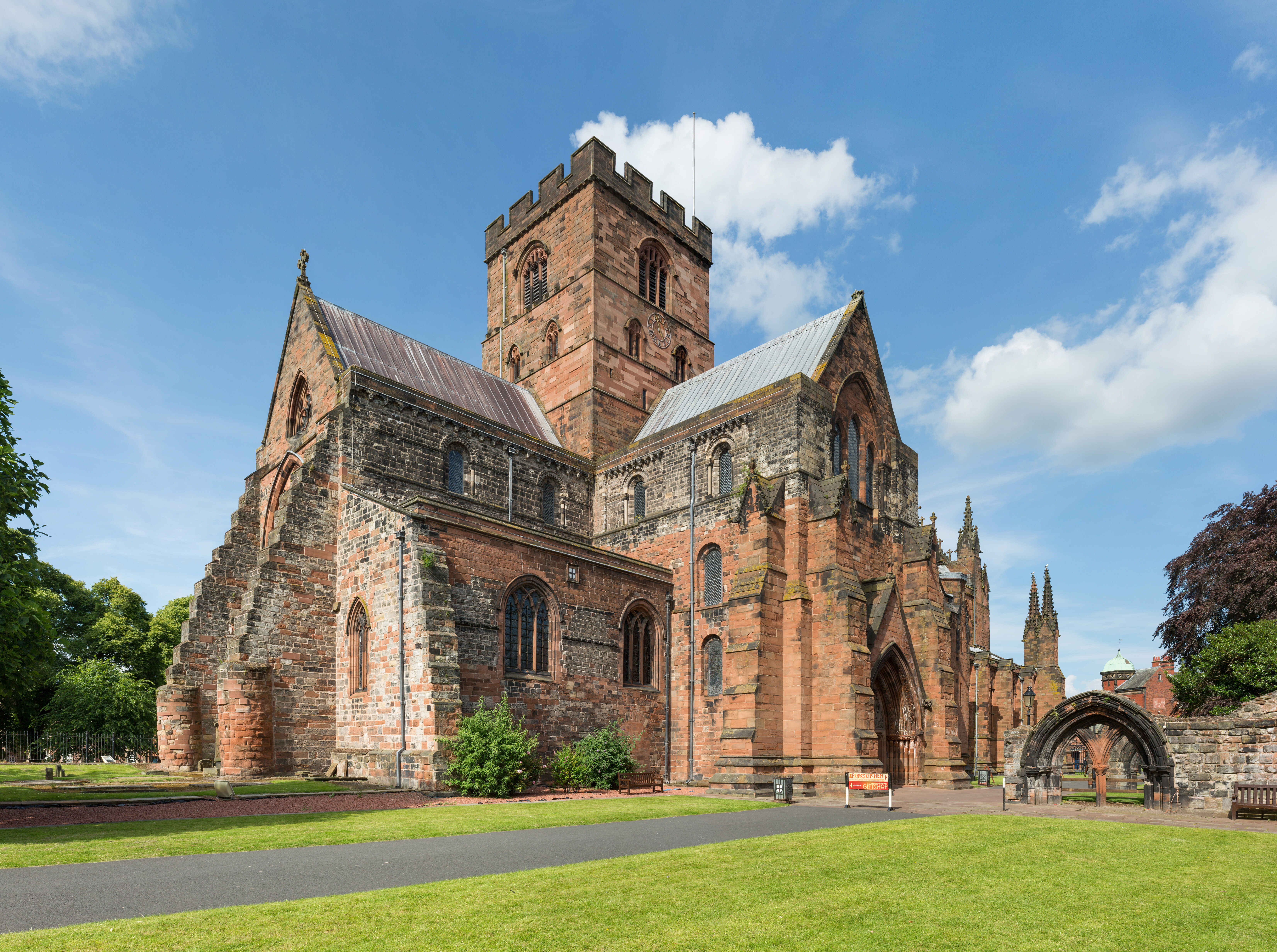|
Nijmegen Helmet
The Nijmegen Helmet is a Roman cavalry sports helmet from the first or second century AD. It was found around 1915 in a gravel bed on the left bank of the Waal river, near the Dutch city of Nijmegen. The helmet would have been worn by the élite Roman cavalry. The head portion of the helmet is made of iron, while the mask and diadem are of bronze or brass. The helmet provides neck protection via a projecting rim overlaid with a thin bronze covering plated with silver. The diadem features two male and three female figures. Several other Roman sports helmets have also been found in or near Nijmegen. Description The remaining portions of the helmet consist of three main parts: a face mask, a brow band, and ear and neck guards on either side. An iron skull cap was designed to closely follow the outline of the wearer's head, although due to significant oxidation, only fragments remain; what remains shows that it was originally skillfully hammered to represent elaborately dressed ... [...More Info...] [...Related Items...] OR: [Wikipedia] [Google] [Baidu] |
Iron
Iron () is a chemical element with symbol Fe (from la, ferrum) and atomic number 26. It is a metal that belongs to the first transition series and group 8 of the periodic table. It is, by mass, the most common element on Earth, right in front of oxygen (32.1% and 30.1%, respectively), forming much of Earth's outer and inner core. It is the fourth most common element in the Earth's crust. In its metallic state, iron is rare in the Earth's crust, limited mainly to deposition by meteorites. Iron ores, by contrast, are among the most abundant in the Earth's crust, although extracting usable metal from them requires kilns or furnaces capable of reaching or higher, about higher than that required to smelt copper. Humans started to master that process in Eurasia during the 2nd millennium BCE and the use of iron tools and weapons began to displace copper alloys, in some regions, only around 1200 BCE. That event is considered the transition from the Bronze Age to the ... [...More Info...] [...Related Items...] OR: [Wikipedia] [Google] [Baidu] |
Society For The Promotion Of Roman Studies
The Society for the Promotion of Roman Studies (The Roman Society) was founded in 1910 as the sister society to the Society for the Promotion of Hellenic Studies. The Society is the leading organisation in the United Kingdom for those interested in the study of Rome and the Roman Empire. Its scope covers Roman history, archaeology, literature and art. History of the society The society was founded at a public meeting in 1910, chaired by Frederic Kenyon, Director of the British Museum, and sponsored by Percy Gardner, George Macmillan, John Penoyre, Francis Haverfield, J. S. Reid, A. H. Smith, G. F. Hill , and G. H. Hallam. The Society's Memorandum and Articles of Association described its major aims as "...to promote Roman studies by creating a library, publishing a journal, and supporting the British School at Rome." The first issue of the ''Journal of Roman Studies'' was published in 1911. Early contributors included Francis Haverfield, Eugénie Strong, Albert Van Bu ... [...More Info...] [...Related Items...] OR: [Wikipedia] [Google] [Baidu] |
1915 Archaeological Discoveries
Events Below, the events of World War I have the "WWI" prefix. January *January – British physicist Sir Joseph Larmor publishes his observations on "The Influence of Local Atmospheric Cooling on Astronomical Refraction". *January 1 ** WWI: British Royal Navy battleship HMS ''Formidable'' is sunk off Lyme Regis, Dorset, England, by an Imperial German Navy U-boat, with the loss of 547 crew. **Battle of Broken Hill: A train ambush near Broken Hill, New South Wales, Australia, is carried out by two men (claiming to be in support of the Ottoman Empire) who are killed, together with 4 civilians. * January 5 – Joseph E. Carberry sets an altitude record of , carrying Capt. Benjamin Delahauf Foulois as a passenger, in a fixed-wing aircraft. * January 12 ** The United States House of Representatives rejects a proposal to give women the right to vote. ** ''A Fool There Was'' premières in the United States, starring Theda Bara as a ''femme fatale''; she quickly becomes one of ... [...More Info...] [...Related Items...] OR: [Wikipedia] [Google] [Baidu] |
Ancient Roman Helmets
Ancient history is a time period from the beginning of writing and recorded human history to as far as late antiquity. The span of recorded history is roughly 5,000 years, beginning with the Sumerian cuneiform script. Ancient history covers all continents inhabited by humans in the period 3000 BCAD 500. The three-age system periodizes ancient history into the Stone Age, the Bronze Age, and the Iron Age, with recorded history generally considered to begin with the Bronze Age. The start and end of the three ages varies between world regions. In many regions the Bronze Age is generally considered to begin a few centuries prior to 3000 BC, while the end of the Iron Age varies from the early first millennium BC in some regions to the late first millennium AD in others. During the time period of ancient history, the world population was already exponentially increasing due to the Neolithic Revolution, which was in full progress. While in 10,000 BC, the world population stood at ... [...More Info...] [...Related Items...] OR: [Wikipedia] [Google] [Baidu] |
Society Of Antiquaries Of Scotland
The Society of Antiquaries of Scotland is the senior antiquarian body of Scotland, with its headquarters in the National Museum of Scotland, Chambers Street, Edinburgh. The Society's aim is to promote the cultural heritage of Scotland. The usual style of Post-nominal letters, post-nominal letters for fellows is FSAScot. History The Society is the oldest antiquarian society in Scotland, and the second-oldest in Britain after the Society of Antiquaries of London. Founded by David Erskine, 11th Earl of Buchan on 18 December 1780, John Stuart, 3rd Earl of Bute, the former Prime Minister of Great Britain, prime minister, was elected the first President. It was incorporated by Royal Charter in 1783, in the same year as the Royal Society of Edinburgh, and in their early years both societies shared accommodation on George Street, Edinburgh, George Street and in the Royal Scottish Academy Building, Royal Institution building on The Mound. Members of the Society collected artefacts of ... [...More Info...] [...Related Items...] OR: [Wikipedia] [Google] [Baidu] |
BBC News
BBC News is an operational business division of the British Broadcasting Corporation (BBC) responsible for the gathering and broadcasting of news and current affairs in the UK and around the world. The department is the world's largest broadcast news organisation and generates about 120 hours of radio and television output each day, as well as online news coverage. The service maintains 50 foreign news bureaus with more than 250 correspondents around the world. Deborah Turness has been the CEO of news and current affairs since September 2022. In 2019, it was reported in an Ofcom report that the BBC spent £136m on news during the period April 2018 to March 2019. BBC News' domestic, global and online news divisions are housed within the largest live newsroom in Europe, in Broadcasting House in central London. Parliamentary coverage is produced and broadcast from studios in London. Through BBC English Regions, the BBC also has regional centres across England and national new ... [...More Info...] [...Related Items...] OR: [Wikipedia] [Google] [Baidu] |
Newstead Helmet
The Newstead Helmet is an iron Roman cavalry helmet dating to 80–100 AD that was discovered at the site of a Roman fort in Newstead, near Melrose in Roxburghshire, Scotland in 1905. It is now part of the Newstead Collection at the National Museum in Edinburgh. The helmet would have been worn by auxiliary cavalrymen in cavalry displays known as '' hippika gymnasia''. Its discoverer, Sir James Curle (1862–1944), described the helmet as "one of the most beautiful things that the receding tide of Roman conquest has left behind". Discovery The helmet was discovered during excavations by James Curle during 1905 at the Roman fort of Trimontium, which is located near the triple peak of Eildon Hill at Newstead, after which the fort is named (Trimontium meaning "three hills"). During excavations between February 1905 and September 1910, Curle discovered a large number of Roman military artefacts at the fort, including items of Roman armour, horse harnesses, saddle plates, and sever ... [...More Info...] [...Related Items...] OR: [Wikipedia] [Google] [Baidu] |
Crosby Garrett Helmet
The Crosby Garrett Helmet is a List of copper alloys, copper alloy Ancient Rome, Roman cavalry helmet dating from the late 2nd or early 3rd century Anno Domini, AD. It was found by an unnamed Metal detector#Archaeology, metal detectorist near Crosby Garrett in Cumbria, England, in May 2010. Later investigations found that a Romano-British farming settlement had occupied the site where the helmet was discovered, which was located a few miles away from a Roman road and a Roman army fort. It is possible that the owner of the helmet was a local inhabitant who had served with the Roman cavalry. The helmet appears to have been deliberately folded up and deposited in an artificial stone structure. It is thought to have been used for ceremonial occasions rather than for combat, and may already have been an antique by the time it was buried. It is of the same type as the Newstead Helmet (found in 1905) and its design also has similarities with the Ribchester Helmet (found in 1796) and the ... [...More Info...] [...Related Items...] OR: [Wikipedia] [Google] [Baidu] |
Cumbria
Cumbria ( ) is a ceremonial and non-metropolitan county in North West England, bordering Scotland. The county and Cumbria County Council, its local government, came into existence in 1974 after the passage of the Local Government Act 1972. Cumbria's county town is Carlisle, in the north of the county. Other major settlements include Barrow-in-Furness, Kendal, Whitehaven and Workington. The administrative county of Cumbria consists of six districts (Allerdale, Barrow-in-Furness, Carlisle, Copeland, Eden and South Lakeland) and, in 2019, had a population of 500,012. Cumbria is one of the most sparsely populated counties in England, with 73.4 people per km2 (190/sq mi). On 1 April 2023, the administrative county of Cumbria will be abolished and replaced with two new unitary authorities: Westmorland and Furness (Barrow-in-Furness, Eden, South Lakeland) and Cumberland (Allerdale, Carlisle, Copeland). Cumbria is the third largest ceremonial county in England by area. It is ... [...More Info...] [...Related Items...] OR: [Wikipedia] [Google] [Baidu] |
Carlisle, Cumbria
Carlisle ( , ; from xcb, Caer Luel) is a city that lies within the Northern English county of Cumbria, south of the Scottish border at the confluence of the rivers Eden, Caldew and Petteril. It is the administrative centre of the City of Carlisle district which, (along with Cumbria County Council) will be replaced by Cumberland Council in April 2023. The city became an established settlement during the Roman Empire to serve forts on Hadrian's Wall. During the Middle Ages, the city was an important military stronghold due to its proximity to the Kingdom of Scotland. Carlisle Castle, still relatively intact, was built in 1092 by William Rufus, served as a prison for Mary, Queen of Scots in 1568 and now houses the Duke of Lancaster's Regiment and the Border Regiment Museum. In the early 12th century, Henry I allowed a priory to be built. The priory gained cathedral status with a diocese in 1133, the city status rules at the time meant the settlement became a city. ... [...More Info...] [...Related Items...] OR: [Wikipedia] [Google] [Baidu] |
Tullie House Museum And Art Gallery
Tullie House Museum and Art Gallery is a museum in Carlisle, England. Opened by the Carlisle Corporation in 1893, the original building is a converted Jacobean mansion, with extensions added when it was converted. At first the building contained the museum and also a library, an art school and a technical school. The building, including the extensions, is a Grade I listed building, and the wall, gates and railings in front of the house are separately Grade I listed. The two schools were moved in the 1950s and the library in 1986. The museum expanded into the city Guildhall in 1980 and with new space available from 1986 it underwent an extensive redevelopment over 1989–90 and again in 2000–01. Since May 2011 the museum has been an independent charitable trust, the Tullie House Museum and Art Gallery Trust. It is one of the three members of the Cumbria Museum Consortium, along with Lakeland Arts and the Wordsworth Trust. In 2012–15 and 2015–18 this co ... [...More Info...] [...Related Items...] OR: [Wikipedia] [Google] [Baidu] |






